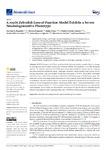A nop56 Zebrafish Loss-of-Function Model Exhibits a Severe Neurodegenerative Phenotype

Use this link to cite
http://hdl.handle.net/2183/31864Collections
- Investigación (FCIE) [1228]
Metadata
Show full item recordTitle
A nop56 Zebrafish Loss-of-Function Model Exhibits a Severe Neurodegenerative PhenotypeAuthor(s)
Date
2022Citation
Quelle-Regaldie, A.; Folgueira, M.; Yáñez, J.; Sobrido-Cameán, D.; Alba-González, A.; Barreiro-Iglesias, A.; Sobrido, M.-J.; Sánchez, L. A nop56 Zebrafish Loss-of-Function Model Exhibits a Severe Neurodegenerative Phenotype. Biomedicines 2022, 10, 1814. https://doi.org/10.3390/biomedicines10081814
Abstract
[Abstract] NOP56 belongs to a C/D box small nucleolar ribonucleoprotein complex that is in charge of cleavage and modification of precursor ribosomal RNAs and assembly of the 60S ribosomal subunit. An intronic expansion in NOP56 gene causes Spinocerebellar Ataxia type 36, a typical late-onset autosomal dominant ataxia. Although vertebrate animal models were created for the intronic expansion, none was studied for the loss of function of NOP56. We studied a zebrafish loss-of-function model of the nop56 gene which shows 70% homology with the human gene. We observed a severe neurodegenerative phenotype in nop56 mutants, characterized mainly by absence of cerebellum, reduced numbers of spinal cord neurons, high levels of apoptosis in the central nervous system (CNS) and impaired movement, resulting in death before 7 days post-fertilization. Gene expression of genes related to C/D box complex, balance and CNS development was impaired in nop56 mutants. In our study, we characterized the first NOP56 loss-of-function vertebrate model, which is important to further understand the role of NOP56 in CNS function and development.
Keywords
Zebrafish
Neurodegeneration
Animal models
Genetic edition
Neurodegeneration
Animal models
Genetic edition
Description
This article belongs to the Special Issue Animal Models of Neurological Disorders: Where Are We Now?
Editor version
Rights
Atribución 4.0 Internacional
ISSN
2227-9059






